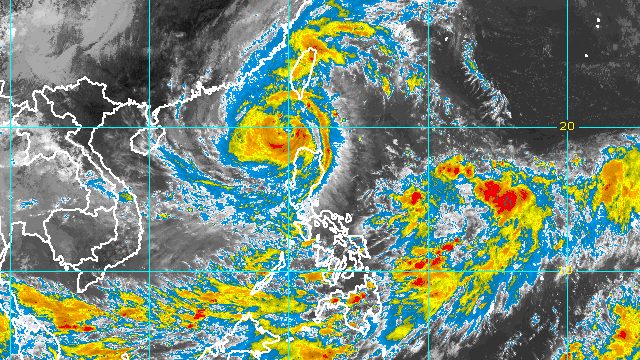SUMMARY
This is AI generated summarization, which may have errors. For context, always refer to the full article.

MANILA, Philippines – Neneng (Nesat) strengthened from a severe tropical storm into a typhoon at 11 am on Sunday, October 16, after undergoing “extreme rapid intensification.”
The Philippine Atmospheric, Geophysical, and Astronomical Services Administration (PAGASA) said in its 2 pm bulletin that Neneng’s maximum sustained winds increased to 120 kilometers per hour, from 100 km/h late Sunday morning. Its gustiness is now up to 150 km/h from the previous 125 km/h.
“Further intensification is likely as this tropical cyclone moves over the West Philippine Sea,” added PAGASA.
Neneng was already 145 kilometers west of Calayan, Cagayan, moving west or away from the country at a slightly slower 20 km/h from the previous 25 km/h.
The typhoon remains on course to exit the Philippine Area of Responsibility (PAR) late Sunday afternoon or evening.
Neneng made landfall in Calayan Island as a severe tropical storm at 3:50 am on Sunday. It dumped torrential rain, particularly in Cagayan and Batanes. Other parts of Northern Luzon have also been affected.
Even as the typhoon is moving away from land, rain persists on Sunday.
Moderate to heavy rain
- Batanes
- Apayao
- Abra
- Benguet
- Ilocos Norte
- Ilocos Sur
Light to moderate rain, with at times heavy rain
- rest of Cordillera Administrative Region
- rest of Ilocos Region
PAGASA also said Neneng’s trough or extension “and the convergence of its circulation with the southwesterly winds induced by the typhoon” could bring occasional rain to the following areas:
- western part of Mimaropa
- western part of Visayas
- northern and western parts of Mindanao
Since Neneng is on its way out, there are fewer areas remaining under tropical cyclone wind signals as of 2 pm on Sunday.
Signal No. 3
Storm-force winds (89 to 117 km/h), moderate to significant threat to life and property
- western part of Babuyan Islands (Panuitan Island, Calayan Island, Dalupiri Island)
Signal No. 2
Gale-force winds (62 to 88 km/h), minor to moderate threat to life and property
- Batanes
- northwestern part of Cagayan (Santa Praxedes, Claveria, Sanchez Mira, Pamplona, Abulug, Ballesteros)
- northwestern part of Apayao (Calanasan, Luna, Santa Marcela)
- Ilocos Norte
Signal No. 1
Strong winds (39 to 61 km/h), minimal to minor threat to life and property
- Kalinga
- Abra
- northern and central parts of Ilocos Sur (Gregorio del Pilar, Magsingal, San Esteban, Banayoyo, Burgos, Candon City, Santa Lucia, Santiago, San Vicente, Santa Catalina, Lidlidda, Nagbukel, Sinait, San Ildefonso, Galimuyod, Vigan City, San Emilio, Cabugao, Caoayan, San Juan, Santa, Bantay, Santo Domingo, Santa Maria, Narvacan, Salcedo, Santa Cruz)
- rest of Apayao
- rest of Cagayan
PAGASA added that there may be occasional gusts in most of Southern Luzon and the Visayas, as well as the eastern parts of Central Luzon, due to the induced southwesterly winds.
Meanwhile, seas remain rough to very rough due to Neneng and the northeasterly surface windflow. The gale warning in effect since 5 am on Sunday covers the following seaboards:
- seaboards of Northern Luzon (Batanes, Cagayan, Ilocos Norte) – waves 3.4 to 5.5 meters high
- eastern and western seaboards of Northern Luzon (Isabela, Ilocos Sur) – waves 3.1 to 4.5 meters high
- western seaboard of Northern Luzon (La Union, Pangasinan) – waves 2.8 to 4.5 meters high
PAGASA advised fishing boats and other small vessels not to sail, and larger vessels to watch out for big waves.
The surge of the northeasterly surface windflow and Neneng may also cause moderate to rough seas in the eastern and western seaboards of Central Luzon as well as the eastern seaboard of Southern Luzon. Waves could be 2 to 3.5 meters high, making conditions risky for small vessels.

Neneng is the Philippines’ 14th tropical cyclone for 2022 and the second for October.
PAGASA expects 5 to 9 tropical cyclones to enter or develop inside PAR from October 2022 to March 2023. Per month, these are the weather bureau’s estimates:
- October 2022 – 2 to 4
- November 2022 – 2 or 3
- December 2022 – 1 or 2
- January 2023 – 0 or 1
- February 2023 – 0 or 1
- March 2023 – 0 or 1
– Rappler.com
Add a comment
How does this make you feel?




There are no comments yet. Add your comment to start the conversation.